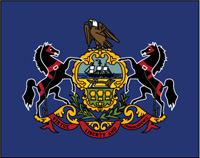 |
THANK YOU!
YOUR PURCHASE OF THESE BOOKS SUPPORTS THE WEB SITES THAT BRING TO YOU THE HISTORY BEHIND OLD AIRFIELD REGISTERS
Your copy of the Davis-Monthan Airfield Register 1925-1936 with all the pilots' signatures and helpful cross-references to pilots and their aircraft is available at the link. 375 pages with black & white photographs and extensive tables
---o0o---
The Congress of Ghosts (available as eBook) is an anniversary celebration for 2010. It is an historical biography, that celebrates the 5th year online of www.dmairfield.org and the 10th year of effort on the project dedicated to analyze and exhibit the history embodied in the Register of the Davis-Monthan Airfield, Tucson, AZ. This book includes over thirty people, aircraft and events that swirled through Tucson between 1925 and 1936. It includes across 277 pages previously unpublished photographs and texts, and facsimiles of personal letters, diaries and military orders. Order your copy at the link.
---o0o---
Military Aircraft of the Davis Monthan Register 1925-1936 is available at the link. This book describes and illustrates with black & white photographs the majority of military aircraft that landed at the Davis-Monthan Airfield between 1925 and 1936. The book includes biographies of some of the pilots who flew the aircraft to Tucson as well as extensive listings of all the pilots and airplanes. Use this FORM to order a copy signed by the author, while supplies last.
---o0o---
Art Goebel's Own Story by Art Goebel (edited by G.W. Hyatt) is written in language that expands for us his life as a Golden Age aviation entrepreneur, who used his aviation exploits to build a business around his passion. Available as a free download at the link.
---o0o---
Winners' Viewpoints: The Great 1927 Trans-Pacific Dole Race (available as eBook) is available at the link. This book describes and illustrates with black & white photographs the majority of military aircraft that landed at the Davis-Monthan Airfield between 1925 and 1936. The book includes biographies of some of the pilots who flew the aircraft to Tucson as well as extensive listings of all the pilots and airplanes. Use this FORM to order a copy signed by the author, while supplies last.
---o0o---
Clover Field: The first Century of Aviation in the Golden State (available in paperback) With the 100th anniversary in 2017 of the use of Clover Field as a place to land aircraft in Santa Monica, this book celebrates that use by exploring some of the people and aircraft that made the airport great. 281 pages, black & white photographs.
---o0o---
A VOCABULARY POINT
You'll note on this site, and all the sites of the suite tabulated at right, that I present BIOGRAPHIES of people relevant to the Registers. For the information on airplanes, I present what I call TECHNOGRAPHIES, which I use to mean a "biography" for a piece of technology. If you look up the definition of technography, it has a different meaning than what I have chosen it to connote. I apologize in advance to the lexicographers who visit my sites.
---o0o---
YOU CAN HELP
I'm looking for information and photographs of the old Pitcairn Fields to include on this page. If you have some you'd like to share, please click this FORM to contact me.
---o0o---
SPONSORED LINKS
HELP KEEP THESE WEB SITES ONLINE
FOR YOUR CONVENIENCE
You may NOW donate via PAYPAL by clicking the "Donate" icon below and using your credit card. You may use your card or your PAYPAL account. You are not required to have a PAYPAL account to donate.
When your donation clears the PAYPAL system, a certified receipt from Delta Mike Airfield, Inc. will be emailed to you for your tax purposes.
---o0o---
Welcome to the Web Site for the Register of Pitcairn Field, Willow Grove, Pennslyvania
NO WHERE ELSE ON THE WORLD WIDE WEB IS THERE A SUITE OF WEB SITES THAT CELEBRATE THE HISTORY OF OLD AIRFIELD REGISTERS, THEIR PEOPLE AND AIRPLANES
You have chosen to enter the suite via Pitcairn Field. Spend some time here by clicking any or all of the navigation buttons at the top and right of any page. When you are finished, you may come back here by clicking HOME and direct your browser to the other sites tabulated, summarized and linked from the travel hub table below. In aggregate, these Registers recorded flight activity around the United States from 1925 to 1942.
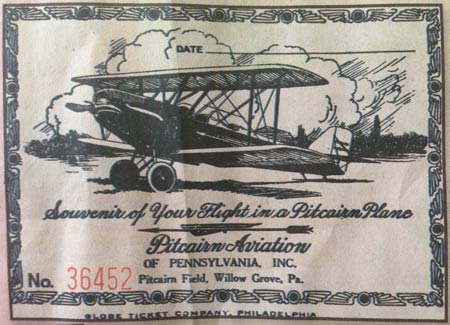 |
|---|
Pitcairn Field has an extraordinary history. It was founded by Harold Pitcairn, one of the fundamental movers and cornerstones of Golden Age aviation. His airfield actually occupied two sites through its life. It became an official airport entity ca. 1916 at a site in Bryn Athyn, PA (see airport diagram farther below).
The second site, at Willow Grove, PA (diagram, farther below), was established ca. 1926. A wonderful summary of both locations of Pitcairn Field is downloadable (PDF 600Kb) at the link. It includes photographs and diagrams. This summary is abridged from the Abandoned & Little-Known Airfields Web site operated by Paul Freeman.
The first site was small, but active. It offered flight training, air shows and pleasure flights as commemorated by the certificate at right, shared with us courtesy of David Pitcairn. An example of an air meet held at the old field is pictured below. The photograph from the Hagley Museum and Library, Wilimington, DE, shows at least two dozen aircraft on the ground, ca. 1925.
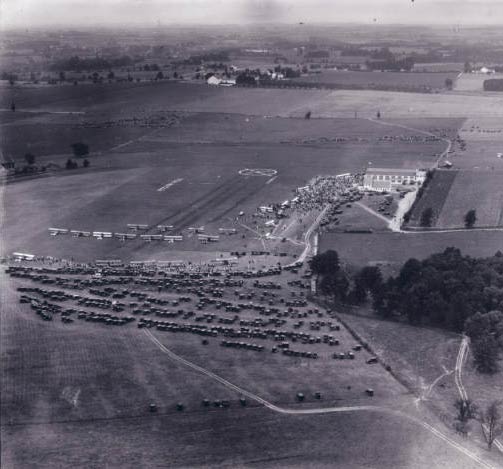 |
|---|
The second airfield site, representing a move to a larger area, resulted from the need to accomodate expanding flight instruction, sightseeing flights, air mail operations and aircraft manufacturing (some manufacturing operations remained at Bryn Athyn).
The Aircraft Yearbook for 1926 gives a sense of the newness of the Willow Grove site, "... Harold F. Pitcairn, president of Pitcairn Aviation, Inc., is a pilot, and also a director of National Air Transport, Inc. The Pitcairn Field is at Willow Grove, Pa. Here are a factory, hangars and ten airplanes. During the first sixteen months of operation by Pitcairn Aviation, Inc., no passenger has suffered the slightest discomfort. In 1925, Mr. Pitcairn's ships made 5,314 flights, covered 63,000 miles and carried 4,168 passengers." Below, an aerial photograph of the Pitcairn manufacturing facility at Willow Grove a few years later, ca. 1930.
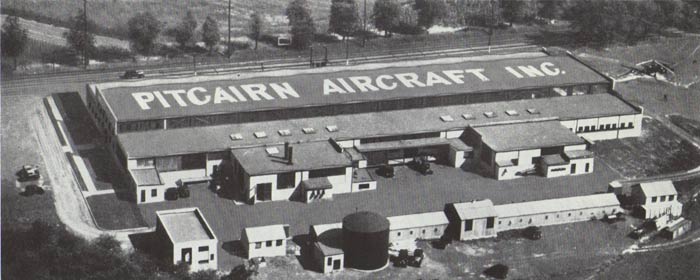 |
|---|
An autogiro sits in the upper right corner of this photograph. This REFERENCE provides a biography of Harold Pitcairn and documents the history of his aviation businesses.
The Pitcairn flying school operation at Willow Grove was advertised in aviation publications of the era. An example from Aeronautics magazine from June,1929 is below (note that other training centers were distributed up and down the east coast).
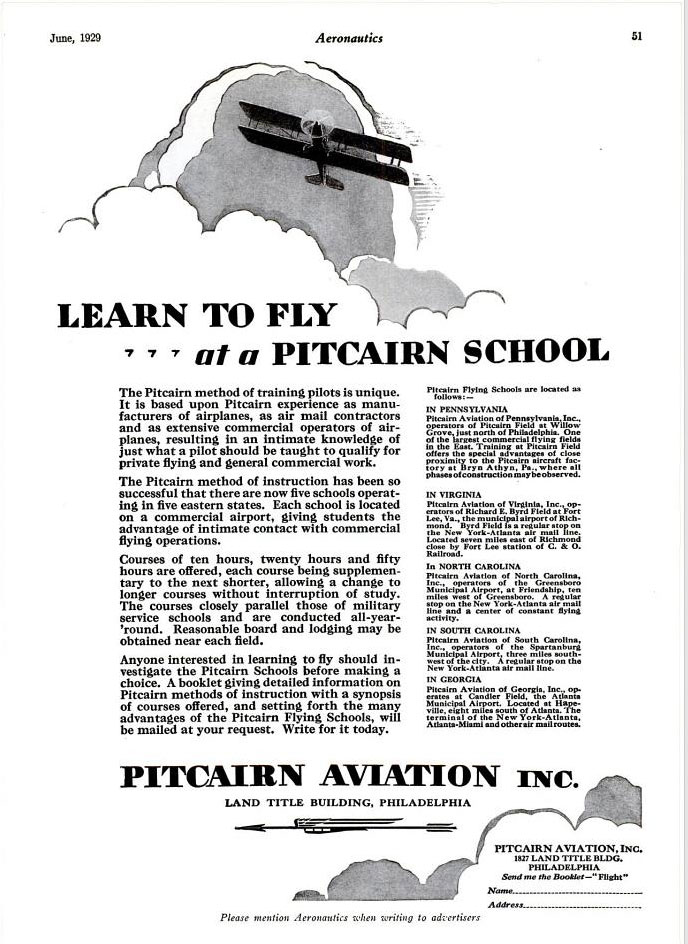 |
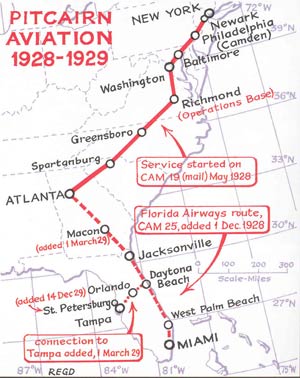 |
|---|
Map, left, courtesy of R.E.G. Davies, shows the route of Pitcairn's Contract Air Mail (CAM) franchise. He operated New York to Atlanta (CAM-19), and later Miami to Atlanta (CAM-25). These routes were sold by Pitcairn to North American Aviation on July 10, 1929 and renamed Eastern Air Transport on Jan. 17, 1930. Eastern Air Transport eventually became Eastern Airlines.
Without the airmail routes, Harold Pitcairn was free to concentrate on production of his Pitcairn Mailwing biplane, which he had developed to fly the mail. But it was so popular among other pilots there was a lucrative business in their manufacture. Likewise, through another business partnership in 1928, Pitcairn began rotary-wing aircraft production in the form of the series of autogiros which, along with the Mailwing, assured the Pitcairn name a place in Golden Age aviation history.
In 1942 Pitcairn sold his Willow Grove airfield to the United States Navy to support their efforts during WWII. And thus the Register was closed January 25, 1942. Please note, while Pitcairn Field operated at two locations from ca. 1916 to ca. 1942, the dates you see in the banner above are the dates that the known REGISTER was kept open at Willow Grove. Click the REGISTER button at top right to learn more.
WHAT AIRFIELDS & REGISTERS CAN BE INVESTIGATED? Please refer to the table below. Each interactive site stands alone. Each is crafted as an attractive and engaging exposition of 20th century aviation history. However, important linkages are made among the sites. You will delight in discovering the overlap in the movements of people and aircraft from Airfield to Airfield, across the United States. The linkages clearly reveal the patterns of air traffic and, more broadly, the evolution of civil, commercial and military aviation in the United States during what historians call the Golden Age of Flight, nominally between the years 1920 and 1940.
This Web site is, in turn, part of a suite of six virtual windows that illuminate old Airfield Registers from around the United States during the Golden Age of flight. The following sites are open to the public. They exhibit and analyze for you 21,667 total airfield traffic days across six Registers. Please explore and enjoy them all!
TRAVEL HUB FOR GOLDEN AGE AIRFIELDS
| Clover Field, Santa Monica, CA WWW.CLOVERFIELD.ORG December 31, 1928 to August 4, 1939 Number of days Register was open = 3,878 Number of landings recorded = 798 over 35 pages Web site went online June 13, 2013 |
Parks Field, East St. Louis, IL |
| Davis-Monthan Municipal Airfield, Tucson, AZ WWW.DMAIRFIELD.ORG February 6, 1925 to November 26, 1936 Number of days Register was open = 3,581 days Number of landings recorded = 3,704 over 218 pages Web site went online May 5, 2005 |
Peterson Field, Colorado Springs, CO WWW.PETERSONFIELD.ORG February 22, 1929 to August 1, 1940 Number of days Register was open = 4,178 Number of landings recorded = 672 over 29 pages Web site went online June 13, 2013 |
| Grand Central Air Terminal, Glendale, CA WWW.GRANDCENTRAL AIR TERMINAL.ORG December 14, 1930 to October 8, 1935 Number of days Register was open = 1,759 Number of landings recorded = NN over N pages Web site went online June 13, 2013 |
Pitcairn Field, Willow Grove, PA WWW.PITCAIRNFIELD.ORG (You're here!) October 22, 1927 to January 25, 1942 Number of days Register was open = 5,240 Number of landings recorded = 328 over 21 pages Web site went online June 13, 2013 |
 |
|---|
WHAT IS AN AIRFIELD REGISTER? Circa 1926, as part of the effort to regulate the growth of air travel, the federal government issued a guideline to airport managers asking that a log be kept of traffic through their ports. At right is a copy of that guideline.
An Airfield Register was most times a large, formatted book in which visiting pilots and passengers wrote their names, the registration numbers of their airplanes, their intended destinations, where they came from, the date and time, and perhaps some remarks. Such books lay open on desks and tables in airport offices and hangars around the United States during the Golden Age. Indeed, many airports today still have Registers open and available for general aviation pilots and passengers to sign.
WHAT IS THE PITCAIRN FIELD REGISTER? The Pitcairn Field Register was an approximately 13.75” L x 10.5” W, case-bound, leather-covered book. The book lay open from October 22, 1927 to January 25, 1942; a total of 5,240 days. It is unknown if there were additional books before or after these dates. If you know of other repositories for Pitcairn Field Register pages or traffic information, please let me KNOW.
You may view each of its pages by clicking the REGISTER button at upper right. The Pitcairn Register was ruled into rows and columns with headers across a single page that specified the information to be entered. It was not a book specially designed as an airfield register. The book could have occupied a hotel lobby desk, for example. Beginning with page 15, someone (now lost to history) began defining more clearly the information that should be entered by pilots. They doubled the width of the area for entering information across two facing pages and penciled in the categories of information to include. Below, an image of part of the top half of page four with data for June, 1928 through February, 1929. This was before two facing pages were used.
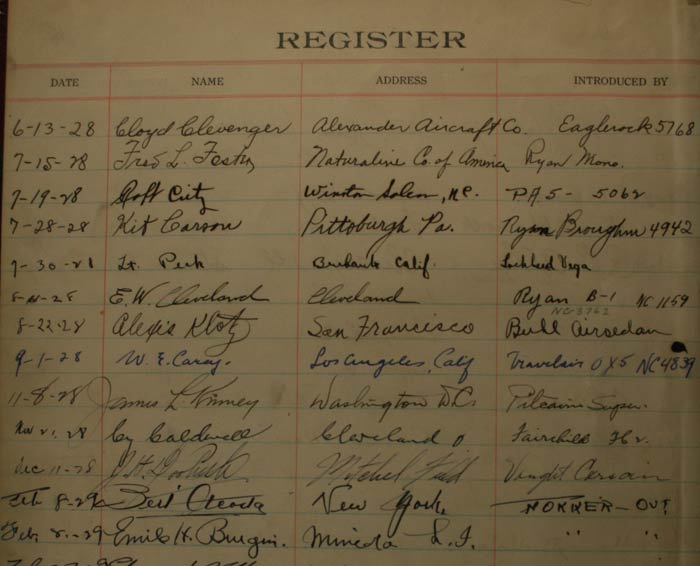 |
|---|
The Pitcairn Register records 328 landings over 21 pages. Compared to other Registers of the Delta Mike Airfield, Inc. suite, the Pitcairn Register was open the longest for pilots to sign (5,240 days), but it recorded the fewest landings (328). I have no explanation for this.
Your Webmaster's copy of the Pitcairn Field Register was photographed by me at Bryn Athyn, PA on October 20, 2010. Thanks to the hospitality of David Pitcairn and staff for arranging permission to review and copy the Register, as well as many other Pitcairn artifacts that are integrated into this Web site.
WHAT WAS PITCAIRN FIELD? As mentioned above, Pitcairn Field occupied two locations. Below, the February 2, 1926 airport diagram from the Aeronautical Bulletin, published by the "Airway Section of the Office of the Chief of Air Service," depicts and describes the Bryn Athyn location.
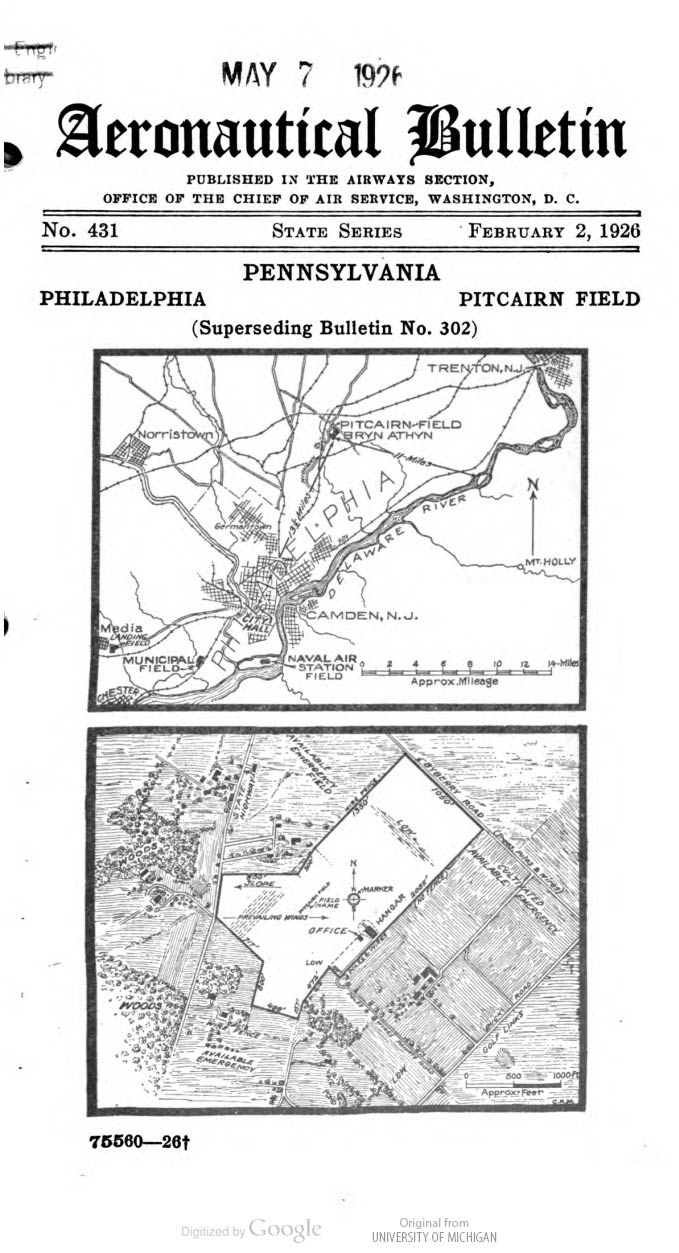 |
|---|
The next page is a physical description of the field. Note that the information was reported two years earlier by Harold Pitcairn.
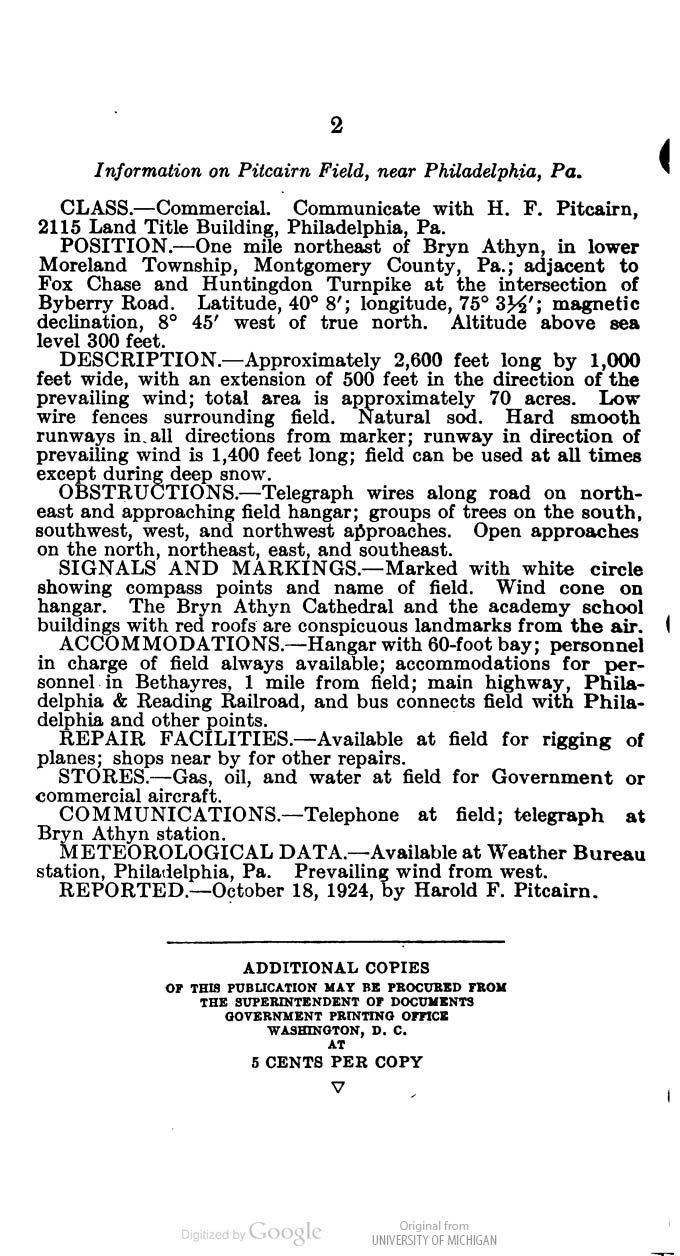 |
|---|
Notably, lots of reorganization occurred around the managment and regulation of aeronautics at the federal level in the United States beginning in 1926. The promulgation of the Air Commerce Act and the formation of the Department of Commerce (DOC) Aeronautical Division resulted in rules for establishing pilot competence, aircraft airworthiness and airport and airway specifications. Pitcairn Field was moved to its new Willow Grove location concurrent with these changes.
For this Web site, which celebrates the Register from the second location, we focus on that field, below. The aerial photograph is from the Aircraft Yearbook, 1926, page 68.
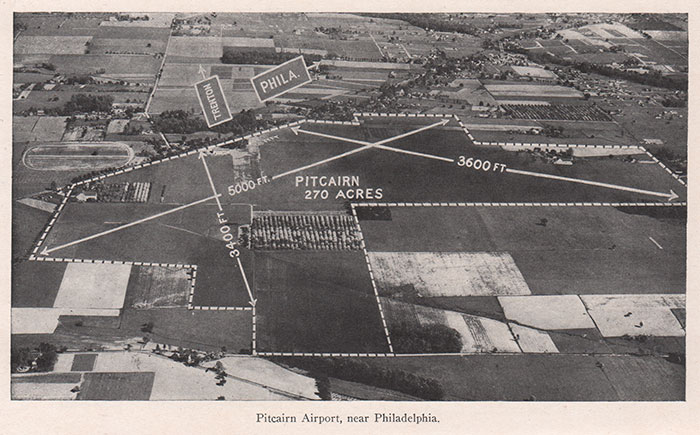 |
Compare this aerial view with the diagram below from the Airway Bulletin, published now by the DOC on July 7, 1927.
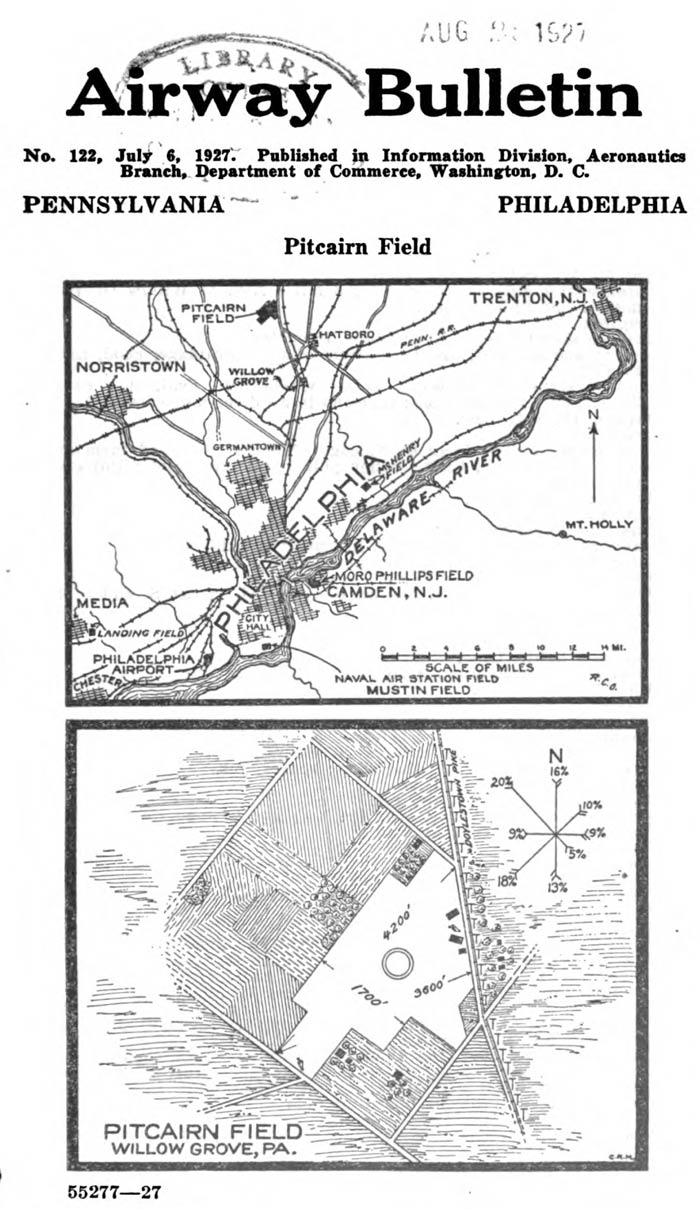 |
|---|
The description defines the Field about a year after the move from Bryn Athyn began. The interesting "wind rose" in the lower panel of the image above denotes the percentage of the time and the direction that wind can be expected at the field. Wind roses became a common image on charts of the time.
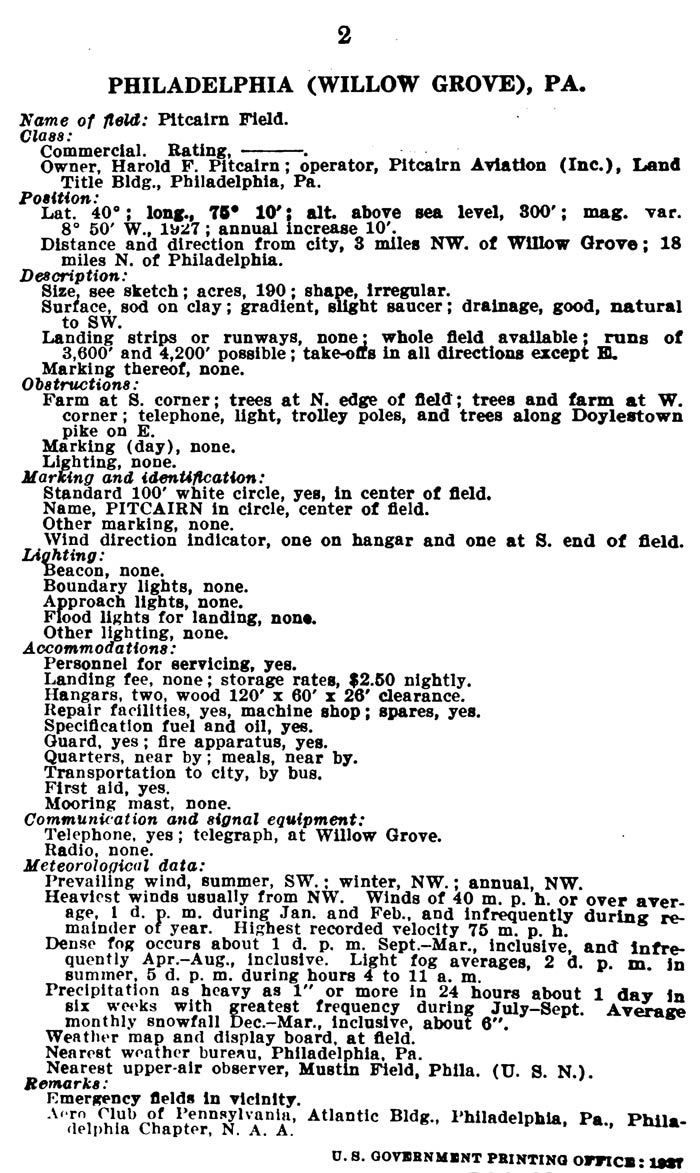 |
|---|
SPONSORED LINKS
WHY BE INTERESTED IN MUSTY, OLD BOOKS? Each Register is a microcosm of Golden Age aviation history, recorded in the first-person, usually by the very actors who made that history. Study of Golden Age people in aviation points to an aerial “lifeway,” including shared values, clothing styles, politics, interests, vocabulary and perhaps even diets and social skills. Being a pilot in those early days was like belonging to an adventure-based brotherhood. But, men did not have a lock on camaraderie. The female pilots, although there weren’t as many of them, shared an equivalent sisterhood that, in many ways, was just a powerful as their male counterparts.
That the women and their exploits were newsworthy at the time is made abundantly clear by the sheer numbers of newspaper and magazine articles and books published. As an example, in one small study I performed, The New York Times published 1,265 articles about female aviators during 1925-1936, an average of three a week. And that is just one newspaper and one small group of aviators.
The machines flown were the best technologies of their time, and the pilots used them in some spectacular, innovative ways. Most of their craft lived hard, short lives. Only a very small percentage exist today, and they and their sister ships are featured on the sites.
The aviation events they competed in (e.g. tours and races) and the records they set, sometimes preserved by entries in the Registers, served to test the mettle of humans and machines and to bring to a curious, and sometimes suspicious, public the opportunity to get close to pilots and their aircraft, and to learn about the utility of aviation in general.
Whereas the Web is infinitely wide, it is many times only a few centimeters deep. Each Register, and their associated Web sites, gives us an opportunity to dive into a deep, virtual pool of information to enjoy meeting the characters and hardware that shaped aeronautical science across the United States through the 20th and into the 21st century. Their influence is palpable today, and will be tomorrow, as we go to the planets and beyond.
PLEASE NOTE: As of the upload date of this page, the Web site of the Davis-Monthan Airfield Register has been online eight years, since May 4, 2005. It presents over 1,000 pages of pilot biographies and other topics, which have been added incrementally over the years. The new sites have less content now, but they will grow over the coming years. Additions and changes to the sites are always posted at the "WHAT'S NEW ON THE SITE?" links on each site. Please bookmark the "What's New on the Site?" pages and come back regularly.
All Web pages are designed by your Webmaster and implemented by The Web Professional, Inc., Naples, FL & St. Paul, MN. All Web sites are wholly owned, researched, written and operated by Delta Mike Airfield, Inc., a 501(c)3 non-profit education company based in Naples, FL. Unless otherwise noted, all designs and original texts and images are Copyright © Delta Mike Airfield, Inc.
The mission of the company is education, encouragement and support of historical aviation research and multi-media publication to enhance knowledge among public and private sectors around the globe. Specific emphasis is on the Golden Age of Flight, nominally between 1920 and 1940. The company operates primarily, but not exclusively, through its Web sites. Other mixed media publications and public appearances also support the Company. Your donations can be made through any of the Web sites.
---o0o---
SPONSORED LINKS
---o0o---
THIS PAGE UPLOADED: 06/13/13 REVISED: 07/31/13, 06/09/13, 06/10/15
